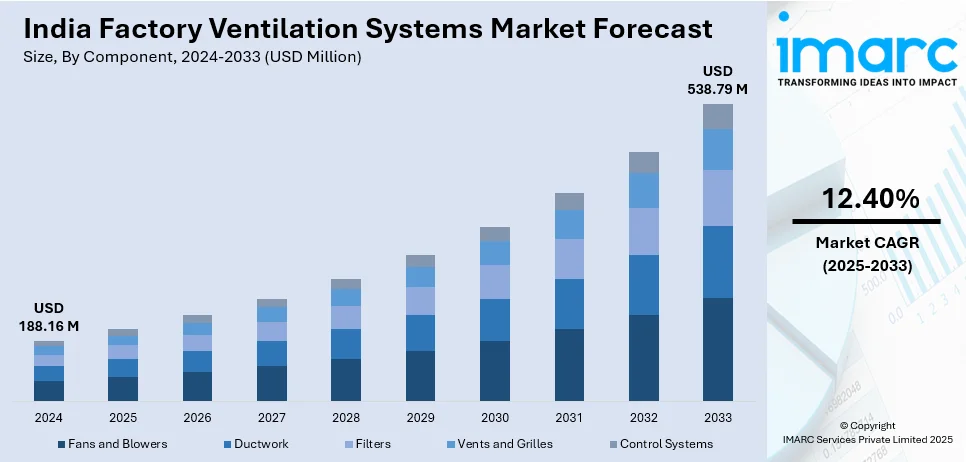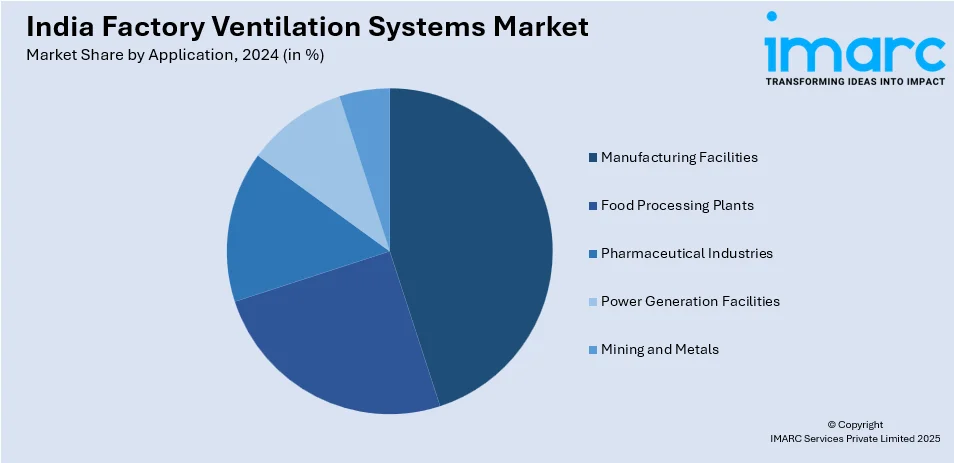
India Factory Ventilation Systems Market Size, Share, Trends and Forecast by Component, Type of Ventilation System, Application, End Use Industry and Region, 2025-2033
India Factory Ventilation Systems Market Overview:
The India factory ventilation systems market size reached USD 188.16 Million in 2024. Looking forward, IMARC Group expects the market to reach USD 538.79 Million by 2033, exhibiting a growth rate (CAGR) of 12.40% during 2025-2033. The market is driven by the growth in industrialization, stringent air quality rules, and rising awareness about worker health and safety issues. The demand for more energy-efficient solutions, technological innovations in ventilation systems, and government efforts toward developing industrial infrastructure are also increasing the India factory ventilation systems market share.
|
Report Attribute
|
Key Statistics
|
|---|---|
|
Base Year
|
2024 |
|
Forecast Years
|
2025-2033
|
|
Historical Years
|
2019-2024
|
| Market Size in 2024 | USD 188.16 Million |
| Market Forecast in 2033 | USD 538.79 Million |
| Market Growth Rate 2025-2033 | 12.40% |
India Factory Ventilation Systems Market Trends:
Adoption of Energy-Efficient Ventilation Systems
In India, there is a rising demand for the installation of energy-efficient ventilation systems in factories. As energy prices continue to rise and environmental issues take center stage, industries are emphasizing carbon footprint and energy reduction. New-age ventilation solutions like demand-controlled ventilation (DCV) and energy recovery ventilators (ERVs) are being adopted on a large scale to achieve maximum air quality with minimum energy consumption. These systems modify airflow according to real-time demands, without wastage of energy, while providing a healthy work environment. As Indian factories are looking to align with environmental policies and increase efforts towards sustainability, the need for energy-efficient solutions is growing further. Recently, the Bureau of Energy Efficiency has called on air-conditioner manufacturers to speed up the introduction of BEE 5-star-rated models that can provide major advantages, such as up to 60% energy savings, lower peak power demand, improved grid stability, and better energy security. In addition, technological advancements are reducing the costs and increasing accessibility of these systems, making them a viable option for factories in different industries ranging from manufacturing to textiles, which is fueling the India factory ventilation systems market growth.

Integration of IoT and Smart Technologies
The convergence of Internet of Things (IoT) and smart technologies is emerging as a major trend in India's factory ventilation systems market. IoT-based ventilation systems enable factory managers to track and regulate air quality, temperature, and humidity in real-time through smart sensors. This technology assists in maintaining optimal ventilation conditions and rapid detection of problems like air contamination, humidity imbalance, or equipment failure. Further, predictive maintenance, enabled by IoT, allows factories to carry out on-time repairs, reducing downtime and increasing operational efficiency. Besides increasing air quality and comfort for employees, the application of smart systems also facilitates cost reduction through optimum energy management. As more businesses adopt digitalization, the inclusion of IoT into factory ventilation systems is expected to expand further, offering efficiency as well as comfort of use as well as integration with smart manufacturing principles.
Increased Focus on Worker Health and Safety
A key trend in the India factory ventilation systems market is the growing concern for employee health and safety. The recent three-day OSH India expo gathered global experts, industry leaders, and more than 250 brands to present innovations and engage in discussions on workplace safety solutions. India's occupational safety and health (OSH) market is thriving, with forecasts suggesting it will hit USD 1 Billion within the next five years. As industrial accidents and respiratory diseases caused by poor air quality have increased, there has been more focus on providing safe working conditions. Factory air systems are today not only built to control temperature but also to remove toxic gases, dust, and contaminants that are prevalent in most manufacturing areas. This phenomenon is especially high in chemicals, textiles, and metalworking sectors where exposure to dangerous substances is high. There has also been a move towards stricter standards from the Indian government for workplace protection, pushing the demand for better-quality air systems. As employee safety takes precedence, factories are allocating funds for top-of-the-line ventilation systems that guarantee conformity with safety measures, enhance the air quality, and minimize the possibilities of health disorders like respiratory infections, thus providing a positive India factory ventilation systems market outlook.
India Factory Ventilation Systems Market Segmentation:
IMARC Group provides an analysis of the key trends in each segment of the market, along with forecasts at the regional level for 2025-2033. Our report has categorized the market based on component, type of ventilation system, application, and end use industry.
Component Insights:
- Fans and Blowers
- Ductwork
- Filters
- Vents and Grilles
- Control Systems
The report has provided a detailed breakup and analysis of the market based on the component. This includes fans and blowers, ductwork, filters, vents and grilles, and control systems.
Type of Ventilation System Insights:
- Natural Ventilation Systems
- Mechanical Ventilation Systems
- Hybrid Ventilation Systems
The report has provided a detailed breakup and analysis of the market based on the type of ventilation system. This includes natural ventilation systems, mechanical ventilation systems, and hybrid ventilation systems.
Application Insights:

- Manufacturing Facilities
- Food Processing Plants
- Pharmaceutical Industries
- Power Generation Facilities
- Mining and Metals
The report has provided a detailed breakup and analysis of the market based on the application. This includes manufacturing facilities, food processing plants, pharmaceutical industries, power generation facilities, and mining and metals.
End Use Industry Insights:
- Manufacturing and Heavy Industries
- Food and Beverage Processing
- Pharmaceuticals and Healthcare
- Electronics and Semiconductor Plants
- Chemical and Petrochemical Industries
- Automotive and Aerospace
- Textiles and Garments
- Others
The report has provided a detailed breakup and analysis of the market based on the end use industry. This includes manufacturing and heavy industries, food and beverage processing, pharmaceuticals and healthcare, electronics and semiconductor plants, chemical and petrochemical industries, automotive and aerospace, textiles and garments, and others.
Regional Insights:
- North India
- South India
- East India
- West India
The report has also provided a comprehensive analysis of all the major regional markets, which include North India, South India, East India, and West India.
Competitive Landscape:
The market research report has also provided a comprehensive analysis of the competitive landscape. Competitive analysis such as market structure, key player positioning, top winning strategies, competitive dashboard, and company evaluation quadrant has been covered in the report. Also, detailed profiles of all major companies have been provided.
India Factory Ventilation Systems Market News:
- In March 2025, Systemair India inaugurated its enlarged factory in Hyderabad, which now encompasses over 20,000 sqm of manufacturing space. Equipped with contemporary amenities and cutting-edge technology, this new location aims to address the increasing need for energy-efficient ventilation options in the area. The growth strengthens Systemair's dedication to innovation, sustainability, and providing high-quality HVAC products. It likewise offers fresh prospects for expansion, skill enhancement, and ongoing progress in the ventilation sector.
India Factory Ventilation Systems Market Report Coverage:
| Report Features | Details |
|---|---|
| Base Year of the Analysis | 2024 |
| Historical Period | 2019-2024 |
| Forecast Period | 2025-2033 |
| Units | Million USD |
| Scope of the Report |
Exploration of Historical Trends and Market Outlook, Industry Catalysts and Challenges, Segment-Wise Historical and Future Market Assessment:
|
| Components Covered | Fans and Blowers, Duct Work, Filters, Vents and Grilles, Control Systems |
| Types of Ventilation System Covered | Natural Ventilation Systems, Mechanical Ventilation Systems, Hybrid Ventilation Systems |
| Applications Covered | Manufacturing Facilities, Food Processing Plants, Pharmaceutical Industries, Power Generation Facilities, Mining and Metals. |
| End Use Industries Covered | Manufacturing and Heavy Industries, Food and Beverage Processing, Pharmaceuticals and Healthcare, Electronics and Semiconductor Plants, Chemical and Petrochemical Industries, Automotive and Aerospace, Textiles and Garments, Others |
| Regions Covered | North India, South India, East India, West India |
| Customization Scope | 10% Free Customization |
| Post-Sale Analyst Support | 10-12 Weeks |
| Delivery Format | PDF and Excel through Email (We can also provide the editable version of the report in PPT/Word format on special request) |
Key Questions Answered in This Report:
- How has the India factory ventilation systems market performed so far and how will it perform in the coming years?
- What is the breakup of the India factory ventilation systems market on the basis of component?
- What is the breakup of the India factory ventilation systems market on the basis of type of ventilation system?
- What is the breakup of the India factory ventilation systems market on the basis of application?
- What is the breakup of the India factory ventilation systems market on the basis of end use industry?
- What is the breakup of the India factory ventilation systems market on the basis of region?
- What are the various stages in the value chain of the India factory ventilation systems market?
- What are the key driving factors and challenges in the India factory ventilation systems market?
- What is the structure of the India factory ventilation systems market and who are the key players?
- What is the degree of competition in the India factory ventilation systems market?
Key Benefits for Stakeholders:
- IMARC’s industry report offers a comprehensive quantitative analysis of various market segments, historical and current market trends, market forecasts, and dynamics of the India factory ventilation systems market from 2019-2033.
- The research report provides the latest information on the market drivers, challenges, and opportunities in the India factory ventilation systems market.
- Porter's five forces analysis assist stakeholders in assessing the impact of new entrants, competitive rivalry, supplier power, buyer power, and the threat of substitution. It helps stakeholders to analyze the level of competition within the India factory ventilation systems industry and its attractiveness.
- Competitive landscape allows stakeholders to understand their competitive environment and provides an insight into the current positions of key players in the market.
Need more help?
- Speak to our experienced analysts for insights on the current market scenarios.
- Include additional segments and countries to customize the report as per your requirement.
- Gain an unparalleled competitive advantage in your domain by understanding how to utilize the report and positively impacting your operations and revenue.
- For further assistance, please connect with our analysts.
 Inquire Before Buying
Inquire Before Buying
 Speak to an Analyst
Speak to an Analyst
 Request Brochure
Request Brochure
 Request Customization
Request Customization




.webp)




.webp)












